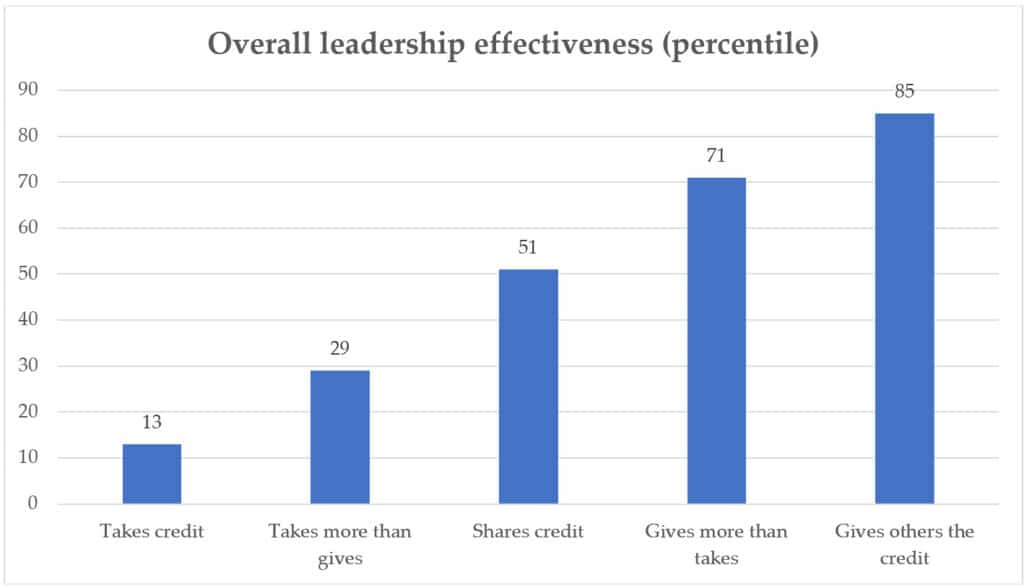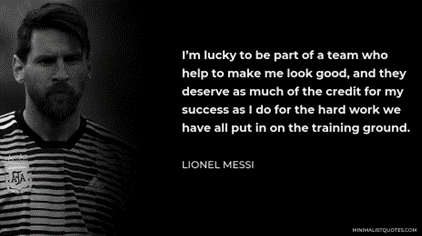Article Summary:
Deciding when to take credit versus give credit for accomplishments is a more complicated issue than many people realize. Generally, it’s best to give credit to others, but there are some scenarios where it’s more nuanced.
+++
The issue of giving versus taking credit for accomplishments is a tricky one for many leaders and organizations. Many of us have worked with people who take credit for others’ work—or who deflect blame when something goes wrong.
Many of us have had our ideas stolen by a colleague or even a boss. We may have worked with glory hounds, attention seekers, or narcissists addicted to the limelight. Or people who spend more time angling for a promotion or seeking credit than actually doing the work. Not fun.
But those are fairly straightforward cases. It turns out that, in many cases, giving and taking credit isn’t as simple as one might think. Often, it’s difficult to ascertain who deserves credit, since there are so many collaborations and interdependencies. Even when someone takes the lead on a big project or drives it, there’s still the issue of others working behind the scenes on scheduling, administration, blocking and tackling, and other forms of support—including taking up the slack on other projects to free that person up.
Another challenge in allocating credit is that standard incentives in many organizations, with compensation tied to performance, can lead to unhealthy behaviors in which people who are hypercompetitive or shameless can manage external perceptions to manipulate their income inappropriately. Some people have no qualms about doing so, perhaps due to their personality, upbringing, or culture. By contrast, humble workers may struggle mightily with anything that might smack of self-promotion.
A similar dynamic can occur when it comes to taking responsibility for things that go wrong. Some people step up instinctively or bravely to accept more than their fair share of the blame, while others run for the hills.
The Consequences of Taking and Giving Credit in Organizations
When credit and blame are misallocated, it has painful consequences, including damaged team morale, diminished collaboration, stifled innovation, and lower performance. This is a big problem, especially in larger organizations that are hierarchical and highly political. In such places, credit tends to flow to the people with title and authority, regardless of their actual contributions.
“One of the great myths of the past decade is that CEOs are primarily responsible for the success of corporations. Rarely is this an accurate picture of how a great company is created…. Great teams create great companies.”
-Bill George, Authentic Leadership
Meanwhile, certain people, including women, minorities, introverts, quiet producers, and people lower in the hierarchy, tend to get neglected. It can be incredibly frustrating for the people who contribute so much, and it can lead to a growing cynicism that damages the culture. Who wants to put in all that extra work if others run away with all the credit?

Leadership Derailers Assessment
Take this assessment to identify what’s inhibiting your leadership effectiveness. It will help you develop self-awareness and identify ways to improve your leadership.
Research on Taking versus Giving Credit
Behavioral statistician Joseph Folkman and his colleagues at Zenger Folkman reviewed assessments from more than 3,800 leaders and measured their effectiveness using 360-degree evaluations from their colleagues (i.e., managers, peers, direct reports, and others). An average of ten people rated each person’s leadership effectiveness and 50 behaviors, including their tendency to take credit from or give credit to others.
The results? Leaders who tend to take credit were rated as very ineffective on their leadership effectiveness (13th percentile), while those who tend to give the credit to others were rated as highly effective (85th percentile). See the chart below.

Folkman summarizes this research as follows:
“Many people underestimate the tremendous impact that comes from making an effort to give credit to others…. While those who assume that by taking credit for others’ work they are getting ahead at work may find that it creates a small temporary advantage for them, the negative impact it creates is like a tsunami wave—eventually it will come back and drown them…. The reality is, when a leader makes another person look good, it makes them look good too.”
When leaders are generous in giving credit to others, according to Folkman, they tend to be perceived as:
- being fair
- being trustworthy
- being responsible
- being values-based
- having integrity (walking their talk)
- being committed to helping others succeed and to doing what’s best for the organization
- valuing diversity
- being more effective as a leader
In his book, Good to Great: Why Some Companies Make the Leap… And Others Don’t, Jim Collins describes the “level 5 leaders” who led the companies that made the transition from merely good to truly great (including financial performance that exceeded the market average by several orders of magnitude over a sustained period of time versus comparison companies). Such leaders displayed a potent combination of personal humility and indomitable will.
Collins observed that it wasn’t that these leaders had no ego. In fact, they were extremely ambitious, but they channeled “their ego needs away from themselves and into the larger goal of building a great company … but their ambition is first and foremost for the institution, not themselves.”
When it came to taking versus giving credit, Collins and his research team noticed a clear pattern:
“In contrast to the very I-centric style of the comparison leaders, we were struck by how the good-to-great leaders didn’t talk about themselves…. When pressed to talk about themselves, they’d say things like… ‘I don’t think I can take much credit. We were blessed with marvelous people.’… Those who worked with or wrote about the good-to-great leaders continually used words like quiet, humble, modest, reserved, shy, gracious, mild-mannered, self-effacing, understated, did not believe his own clippings, and so forth.” -Jim Collins, Good to Great
Writing in Harvard Business Review, Tobias Fredberg of the TruePoint Center for Higher Ambition Leadership notes an example of such a leader. After leading his company through a brutal and harrowing turnaround, Carl Bennet, primary owner and chairman of Getinge AB (a Swedish medical technology company), demurred, “Anyone could have done it. It was a great company just waiting for somebody to care about it.”
We can also see how getting this wrong can be damaging to leaders and teams. In their book, True North: Emerging Leader Edition, Bill George and Zach Clayton note that one of the five archetypes of derailing for leaders is what they call “glory seekers.” Those are the leaders who define themselves by the acclaim of others instead of by their own guiding lights and “true north” principles.
So far, we’ve seen that it’s generally best to be humble and give credit to others, but are there situations in which it’s more nuanced? Below, we address three common scenarios and how there might be a different approach toward giving versus taking credit.

Personal Values Exercise
Complete this exercise to identify your personal values. It will help you develop self-awareness, including clarity about what’s most important to you in life and work, and serve as a safe harbor for you to return to when things are tough.
Scenario #1: Safe and Secure
Let’s start with people who are safe and secure in their position and don’t have to worry about threats to their ability to continue doing what they’re doing. This can be top-level executives who have reached the pinnacle of their career, or it can be solid performers whose work is well known and widely appreciated and who don’t wish to climb the opportunity ladder any further.
In this case, when accolades come their way, they can say something like:
“They did it. They get the credit.”
The emphasis here is on “they,” not “me.” (1)
Best Practices for Leaders in Giving Credit
Though giving credit may sound simple and straightforward, it has some important nuances that are easy to overlook. Here are some best practices for leaders:
Good leaders refuse to tolerate people who are shameless self-promoters and not sufficiently committed to the team. They address such cases with what we call “steel leadership” (using the hard power of positional authority and strength of will to defend important commitments). In doing so, they’re building a culture of mutual appreciation and commitment.
Good leaders are on the lookout for the quiet performers who give it their all even while getting neglected from the spotlight. They look for ways to celebrate the quiet performers publicly and elevate them as models of excellence. In doing so, they generate goodwill and espirit de corps.
Good leaders are clear and specific in giving credit. They don’t shower credit on everyone all the time. That would dilute its impact dramatically, defeating the point. They’re careful observers and precise purveyors of credit so people can see they’re watching closely and following up with thanks and specific recognition and praise.
“There are two things people want more than sex and money—recognition and praise.”
-Mary Kay Ash, founder, Mary Kay Inc.
Good leaders give people credit even when they’re not present, and they’re intentional about it in their written communication as well (e.g., copying key managers, senior executives, or board members on emails noting people’s key contributions to important work). Other people see that it’s not something leaders are doing to ingratiate themselves with their direct reports; rather, it’s a matter of principle and honor—and a point of genuine connection among colleagues who truly care for each other.
Good leaders recognize people when they give credit to others or share it (i.e., praising those who properly recognize others). Leaders incentivize such credit-giving and credit-sharing. By doing so, they’re sending a signal that giving credit is important and valued in the organization—and that they’re all in this together. Managers can even build this practice into performance reviews, regularly revisiting how people are doing on this front.
“As a leader, you need to pay more attention to the allocation of credit and blame to individuals so—perhaps paradoxically—your team pays less attention to it. If you do, they’ll start performing in a way that is more collectively creditworthy.”
-Ben Dattner, “Give Credit Where It’s Due,” Harvard Business Review, March 27, 2012
Scenario #2: Aspiring Leaders and Ambitious Professionals
A second scenario concerns aspiring leaders and ambitious professionals when they’re fairly safe and secure in the organization, but things are potentially fluid and dynamic. Things are changing or could change quickly.
When receiving praise, these folks may want to say something like this:
“Yes, we did it.”
The emphasis here is on “we,” not “me.”
People here should be thoughtful about noting their own role in the results. They can’t afford to take too much credit because that would unfairly diminish the contributions of others. It must be a genuine acknowledgement of their combined efforts while remaining humble and sharing credit liberally.
People in this situation may not be able to afford to defer all the credit, often because they may still have some personal brand-building to do. (2) They should recognize the worth of what their colleagues did and acknowledge and praise them appropriately.
This scenario focuses on sharing credit but also pays some attention to personal brand-building, which comes with important benefits, including:
- enhanced visibility
- greater job security
- expanded network
- better positioning for new opportunities (e.g., promotion, pay raise, or new job)

Alignment Scorecard
When organizations aren’t aligned, it can reduce performance dramatically and cause frustration and dysfunction. With this Alignment Scorecard, you can assess your organization’s level of alignment and make plans for improving it.
Scenario #3: Uncertainty and Insecurity
In this third scenario, people may face a significant amount of uncertainty or insecurity about their future in their organization, or they may be content where they are. First, they may be in danger due to a host of factors, including economic uncertainty, organizational distress, or a cutthroat up-or-out culture that often weeds people out. People in these situations are wise to ensure their contributions aren’t overlooked—to ensure they’re not forgotten in the internal competition of the organization.
Second, if they’re happy where they are and not vying for upward mobility, the danger is that they may not seem like committed team members ready to sacrifice for the organization. Their motives may be misunderstood, and their commitment may be questioned. They risk getting less than what they deserve in compensation, title, or recognition—or even getting laid off in tough times.
In these cases, people may want to make their accomplishments known with something like this:
“Yes, I did it, and I appreciate all the help from person A in handling X and from person B in taking care of Y.”
Such an approach can help ensure they’re not overlooked while also crediting the contributions of others. In addition, if they’re particularly vulnerable, they may want to keep track of their tasks and accomplishments in case there are disputes or cases in which others are falsely taking credit for their work.
Conclusion
Clearly, given all the dynamics at work, there’s no single formula for how to proceed for how to decide when to give or take credit. There are no precise rules to follow in all cases.
We’re wise to give as much credit to our colleagues as we can while also remaining authentic and avoiding false humility designed to manipulate. When in doubt, we should err on the side of giving credit and recognizing others, but also pay attention to whether we’re vulnerable to glory hounds or to being overlooked in uncertain environments.
It’s unfortunate that the topic of taking versus giving credit is often neglected, because handling this well can be a real driver of performance and a big boost to individual and team motivation and effort.

Reflection Questions
- How do you approach taking versus giving credit?
- What do you notice about how others handle it, including those you admire and those whose approach doesn’t sit well with you?
- What will you do differently going forward?
Tools for You
- Leadership Derailers Assessment to help you identify what’s inhibiting your leadership effectiveness
- Personal Values Exercise to help you determine and clarify what’s most important to you
- Alignment Scorecard to help you assess your organization’s level of alignment

Leadership Derailers Assessment
Take this assessment to identify what’s inhibiting your leadership effectiveness. It will help you develop self-awareness and identify ways to improve your leadership.
Related Articles
- “How Great Leaders Reward, Recognize, and Celebrate People”
- “The Importance of Trust in Leadership”
- “The Importance of Credibility in Leadership”
- “Leaders, Do You Have Your People’s Backs?”
- “The Importance of Heart in Leadership”
Postscript: Quotations on Giving versus Taking Credit
- “It is amazing what you can accomplish if you do not care who gets the credit.” -Harry S. Truman, former U.S. president
- “If anything goes bad, I did it. If anything goes semi-good, we did it. If anything goes really good, then you did it. That’s all it takes to get people to win football games for you.” -Paul William “Bear” Bryant, legendary American college football coach
- “A leader is best when people barely know he exists, when his work is done, his aim fulfilled, they will say: we did it ourselves.” -Lao Tzu, ancient Chinese philosopher
- “Soldiers generally win battles; generals get credit for them.” -Napoleon Bonaparte, French emperor and military commander
- “A good leader takes a little more than his share of the blame, a little less than his share of the credit.” -Arnold H. Glasow, American businessman and satirist
- “Great discoveries and improvements invariably involve the cooperation of many minds. I may be given credit for having blazed the trail, but when I look at the subsequent developments I feel the credit is due to others rather than to myself.” -Alexander Graham Bell, American inventor
- “Humility is the true key to success. Successful people lose their way at times. They often embrace and overindulge from the fruits of success. Humility halts this arrogance and self-indulging trap. Humble people share the credit and wealth, remaining focused and hungry to continue the journey of success.” -Rick Pitino, American basketball coach
- “We always take credit for the good and attribute the bad to fortune.” -Charles Kuralt, American journalist
(1) A caution here for top executives: beware a false sense of security. Even top executives can be vulnerable. Market conditions can change quickly. Rivals can rocket forward. And boards can be out to lunch or not see the contributions and impacts of their own executives.
(2) “Much of professional and personal success depends on persuading others to recognize your value. You have to do this when you apply for jobs, ask for promotions, vie for leadership positions, or write your dating profile. For better or worse, in today’s world everyone is a brand, and you need to develop yours and get comfortable marketing it. Personal branding is an intentional, strategic practice in which you define and express your own value proposition.” -Jill Avery and Rachel Greenwald, “A New Approach to Building Your Personal Brand,” Harvard Business Review, May-June 2023

Triple Crown Leadership Newsletter
Join our community. Sign up now and get our monthly inspirations (new articles, announcements, opportunities, resources, and more). Welcome!
+++++++++++++++++++++++
Gregg Vanourek and Bob Vanourek are leadership practitioners, teachers, and award-winning authors (and son and father). They are co-authors of Triple Crown Leadership: Building Excellent, Ethical, and Enduring Organizations, a winner of the International Book Awards. Check out their Leadership Derailers Assessment or get their monthly newsletter. If you found value in this, please forward it to a friend. Every little bit helps!



